Temporal Stability of Grassland Soil Moisture Utilising Sentinel-2 Satellites and Sparse Ground-Based Sensor Networks
Abstract
1. Introduction
2. Data and Methods
2.1. Study Area
2.2. Satellite and In Situ Data
2.3. OPTRAM Basics
2.4. Relationships between VSM and nSSM
2.5. Considerations for Implementing OPTRAM
2.5.1. Choice of Vegetation Index
2.5.2. Determination of Edge Curves and Calculation of nSSM
2.5.3. Land Cover Masks
2.5.4. Normalised SSM and Time-Delayed VSM Data
2.6. Temporal Stability (TS) Metrics
3. Results
3.1. Satellite and VSM Data
3.2. Choice of Vegetation Index
3.3. Fitting of Edge Curves
3.4. Relationships between Satellite and In Situ Sensor Soil Moisture
3.5. Maps of nSSM
3.6. Temporal Stability of nSSM
4. Discussion
4.1. Edge Curves and Vegetation Index
4.2. Variable Vegetation Cover and Soil Moisture
4.3. Time-Delayed VSM and nSSM
4.4. Satellite-Derived Surface Moisture TS for Land-Use Management
5. Conclusions
- (1)
- An exploration of four vegetation indices used in scatter plots of STR-VI identified EVI as the index which provided upper and lower boundaries (wet and dry edges, respectively) best suited to estimate normalised surface soil moisture. The wet and dry edges in the STR-VI space were clearly non-linear and could be characterised, for example, using a double logistic function.
- (2)
- The introduction of a time lag for the responses of in situ volumetric soil moisture sensors improved correlations with the normalised soil moisture by a factor of ~2 but only if S-2 data were used at the start of a dry-down period. The time lag was estimated from a semi-empirical solution to the Richards’ Equation and measurements of residual and saturated soil moisture from field soil samples. The results are comparable with other validation studies despite the sparse sensor networks in this study.
- (3)
- Retrievals of OPTRAM normalised surface soil moisture are most suited to temporal stability analyses, given the absence of regular time series of satellite optical data in cloudy regions.
- (4)
- An interpretation of the surface soil moisture temporal stability, where local topographic controls on subsurface-water flow are negligible and the vegetation type is uniform, suggest that local areas are systematically wetter or dryer than their surroundings. This is associated with local drainage, hydraulic conductivity and soil texture.
Supplementary Materials
Author Contributions
Funding
Data Availability Statement
Acknowledgments
Conflicts of Interest
References
- Global Climate Observing System, (GCOS). Available online: https://gcos.wmo.int/en/essential-climate-variables/soil-moisture (accessed on 20 October 2022).
- Vereecken, H.; Huisman, J.A.; Pachepsky, Y.; Montzka, C.; van der Kruk, J.; Bogena, H.; Weihermüller, L.; Herbst, M.; Martinez, G.; Vanderborght, J. On the Spatio-Temporal Dynamics of Soil Moisture at the Field Scale. J. Hydrol. 2014, 516, 76–96. [Google Scholar] [CrossRef]
- Berg, A.; Sheffield, J. Climate Change and Drought: The Soil Moisture Perspective. Curr. Clim. Chang. Reports 2018, 4, 180–191. [Google Scholar] [CrossRef]
- Seneviratne, S.I.; Corti, T.; Davin, E.L.; Hirschi, M.; Jaeger, E.B.; Lehner, I.; Orlowsky, B.; Teuling, A.J. Investigating Soil Moisture-Climate Interactions in a Changing Climate: A Review. Earth-Science Rev. 2010, 99, 125–161. [Google Scholar] [CrossRef]
- Mimeau, L.; Tramblay, Y.; Brocca, L.; Massari, C.; Camici, S.; Finaud-Guyot, P. Modeling the Response of Soil Moisture to Climate Variability in the Mediterranean Region. Hydrol. Earth Syst. Sci. 2021, 25, 653–669. [Google Scholar] [CrossRef]
- Krueger, E.S.; Ochsner, T.E.; Levi, M.R.; Basara, J.B.; Snitker, G.J.; Wyatt, B.M. Grassland Productivity Estimates Informed by Soil Moisture Measurements: Statistical and Mechanistic Approaches. Agron. J. 2021, 113, 3498–3517. [Google Scholar] [CrossRef]
- Tuohy, P.; Fenton, O.; Holden, N.M.; Humphreys, J. The Effects of Treading by Two Breeds of Dairy Cow with Different Live Weights on Soil Physical Properties, Poaching Damage and Herbage Production on a Poorly Drained Clay-Loam Soil. J. Agric. Sci. 2015, 153, 1424–1436. [Google Scholar] [CrossRef] [PubMed]
- Robinson, D.A.; Campbell, C.S.; Hopmans, J.W.; Hornbuckle, B.K.; Jones, S.B.; Knight, R.; Ogden, F.; Selker, J.; Wendroth, O. Soil Moisture Measurement for Ecological and Hydrological Watershed-Scale Observatories: A Review. Vadose Zone J. 2008, 7, 358–389. [Google Scholar] [CrossRef]
- Babaeian, E.; Sadeghi, M.; Jones, S.B.; Montzka, C.; Vereecken, H.; Tuller, M. Ground, Proximal, and Satellite Remote Sensing of Soil Moisture. Rev. Geophys. 2019, 57, 530–616. [Google Scholar] [CrossRef]
- Sheng, W.; Zhou, R.; Sadeghi, M.; Babaeian, E.; Robinson, D.A.; Tuller, M.; Jones, S.B. A TDR Array Probe for Monitoring Near-Surface Soil Moisture Distribution. Vadose Zone J. 2017, 16, 1–8. [Google Scholar] [CrossRef]
- Petropoulos, G.P.; Griffiths, H.M.; Dorigo, W.; Xaver, A.; Gruber, A. Surface Soil Moisture Estimation: Significance, Controls, and Conventional Measurement Techniques. In Remote Sensing of Energy Fluxes and Soil Moisture Content; CRC Press: Boca Raton, FL, USA, 2013; pp. 29–48. ISBN 9781466505797. [Google Scholar]
- Robock, A.; Vinnikov, K.Y.; Srinivasan, G.; Entin, J.K.; Hollinger, S.E.; Speranskaya, N.A.; Liu, S.; Namkhai, A. The Global Soil Moisture Data Bank. Bull. Am. Meteorol. Soc. 2000, 81, 1281–1299. [Google Scholar] [CrossRef]
- Zhang, D.; Zhou, G. Estimation of Soil Moisture from Optical and Thermal Remote Sensing: A Review. Sensors 2016, 16, 1308. [Google Scholar] [CrossRef] [PubMed]
- Mohanty, B.P.; Cosh, M.H.; Lakshmi, V.; Montzka, C. Soil Moisture Remote Sensing: State-of-the-Science. Vadose Zone J. 2017, 16, 1–9. [Google Scholar] [CrossRef]
- Petropoulos, G.P.; Ireland, G.; Barrett, B. Surface Soil Moisture Retrievals from Remote Sensing: Current Status, Products & Future Trends. Phys. Chem. Earth 2015, 83–84, 36–56. [Google Scholar]
- Sadeghi, M.; Babaeian, E.; Tuller, M.; Jones, S.B. The Optical Trapezoid Model: A Novel Approach to Remote Sensing of Soil Moisture Applied to Sentinel-2 and Landsat-8 Observations. Remote Sens. Environ. 2017, 198, 52–68. [Google Scholar] [CrossRef]
- Shafian, S.; Maas, S.J. Index of Soil Moisture Using Raw Landsat Image Digital Count Data in Texas High Plains. Remote Sens. 2015, 7, 2352–2372. [Google Scholar] [CrossRef]
- Entekhabi, D.; Njoku, E.G.; O’Neill, P.E.; Kellogg, K.H.; Crow, W.T.; Edelstein, W.N.; Entin, J.K.; Goodman, S.D.; Jackson, T.J.; Johnson, J.; et al. The Soil Moisture Active Passive (SMAP) Mission. Proc. IEEE 2010, 98, 704–716. [Google Scholar] [CrossRef]
- Kerr, Y.H.; Waldteufel, P.; Wigneron, J.P.; Delwart, S.; Cabot, F.; Boutin, J.; Escorihuela, M.J.; Font, J.; Reul, N.; Gruhier, C.; et al. The SMOS L: New Tool for Monitoring Key Elements Ofthe Global Water Cycle. Proc. IEEE 2010, 98, 666–687. [Google Scholar] [CrossRef]
- Wagner, W.; Hahn, S.; Kidd, R.; Melzer, T.; Bartalis, Z.; Hasenauer, S.; Figa-Saldaña, J.; De Rosnay, P.; Jann, A.; Schneider, S.; et al. The ASCAT Soil Moisture Product: A Review of Its Specifications, Validation Results, and Emerging Applications. Meteorol. Z. 2013, 22, 5–33. [Google Scholar] [CrossRef]
- Bhogapurapu, N.; Dey, S.; Homayouni, S.; Bhattacharya, A.; Rao, Y.S. Field-Scale Soil Moisture Estimation Using Sentinel-1 GRD SAR Data. Adv. Sp. Res. 2022, 70, 3845–3858. [Google Scholar] [CrossRef]
- Singh, A.; Gaurav, K.; Meena, G.K.; Kumar, S. Estimation of Soil Moisture Applying Modified Dubois Model to Sentinel-1; A Regional Study from Central India. Remote Sens. 2020, 12, 2266. [Google Scholar] [CrossRef]
- Bauer-Marschallinger, B.; Freeman, V.; Cao, S.; Paulik, C.; Schaufler, S.; Stachl, T.; Modanesi, S.; Massari, C.; Ciabatta, L.; Brocca, L.; et al. Toward Global Soil Moisture Monitoring with Sentinel-1: Harnessing Assets and Overcoming Obstacles. IEEE Trans. Geosci. Remote Sens. 2019, 57, 520–539. [Google Scholar] [CrossRef]
- Das, N.N.; Entekhabi, D.; Dunbar, R.S.; Chaubell, M.J.; Colliander, A.; Yueh, S.; Jagdhuber, T.; Chen, F.; Crow, W.; O’Neill, P.E.; et al. The SMAP and Copernicus Sentinel 1A/B Microwave Active-Passive High Resolution Surface Soil Moisture Product. Remote Sens. Environ. 2019, 233, 111380. [Google Scholar] [CrossRef]
- Peng, J.; Albergel, C.; Balenzano, A.; Brocca, L.; Cartus, O.; Cosh, M.H.; Crow, W.T.; Dabrowska-Zielinska, K.; Dadson, S.; Davidson, M.W.J.; et al. A Roadmap for High-Resolution Satellite Soil Moisture Applications—Confronting Product Characteristics with User Requirements. Remote Sens. Environ. 2021, 252, 112162. [Google Scholar] [CrossRef]
- Dorigo, W.; Himmelbauer, I.; Aberer, D.; Schremmer, L.; Petrakovic, I.; Zappa, L.; Preimesberger, W.; Xaver, A.; Annor, F.; Ardö, J.; et al. The International Soil Moisture Network: Serving Earth System Science for over a Decade. Hydrol. Earth Syst. Sci. 2021, 25, 5749–5804. [Google Scholar] [CrossRef]
- Bogena, H.R.; Huisman, J.A.; Güntner, A.; Hübner, C.; Kusche, J.; Jonard, F.; Vey, S.; Vereecken, H. Emerging Methods for Noninvasive Sensing of Soil Moisture Dynamics from Field to Catchment Scale: A Review. Wiley Interdiscip. Rev. Water 2015, 2, 635–647. [Google Scholar] [CrossRef]
- Gruber, A.; De Lannoy, G.; Albergel, C.; Al-Yaari, A.; Brocca, L.; Calvet, J.C.; Colliander, A.; Cosh, M.; Crow, W.; Dorigo, W.; et al. Validation Practices for Satellite Soil Moisture Retrievals: What Are (the) Errors? Remote Sens. Environ. 2020, 244, 111806. [Google Scholar] [CrossRef]
- Cui, D.; Liang, S.; Wang, D. Observed and Projected Changes in Global Climate Zones Based on Köppen Climate Classification. Wiley Interdiscip. Rev. Clim. Chang. 2021, 12, e701. [Google Scholar] [CrossRef]
- Mananze, S.; Pôças, I. Agricultural Drought Monitoring Based on Soil Moisture Derived from the Optical Trapezoid Model in Mozambique. J. Appl. Remote Sens. 2019, 13, 024519. [Google Scholar] [CrossRef]
- Acharya, U.; Daigh, A.L.M.; Oduor, P.G. Soil Moisture Mapping with Moisture-Related Indices, OPTRAM, and an Integrated Random Forest-OPTRAM Algorithm from Landsat 8 Images. Remote Sens. 2022, 14, 3801. [Google Scholar] [CrossRef]
- Babaeian, E.; Sadeghi, M.; Franz, T.E.; Jones, S.; Tuller, M. Mapping Soil Moisture with the OPtical TRApezoid Model (OPTRAM) Based on Long-Term MODIS Observations. Remote Sens. Environ. 2018, 211, 425–440. [Google Scholar] [CrossRef]
- Chen, M.; Zhang, Y.; Yao, Y.; Lu, J.; Pu, X.; Hu, T.; Wang, P. Evaluation of the OPTRAM Model to Retrieve Soil Moisture in the Sanjiang Plain of Northeast China. Earth Sp. Sci. 2020, 7, e2020EA001108. [Google Scholar] [CrossRef]
- Sun, H.; Liu, H.; Ma, Y.; Xia, Q. Optical Remote Sensing Indexes of Soil Moisture: Evaluation and Improvement Based on Aircraft Experiment Observations. Remote Sens. 2021, 13, 4638. [Google Scholar] [CrossRef]
- Babaeian, E.; Sidike, P.; Newcomb, M.S.; Maimaitijiang, M.; White, S.A.; Demieville, J.; Ward, R.W.; Sadeghi, M.; LeBauer, D.S.; Jones, S.B.; et al. A New Optical Remote Sensing Technique for High-Resolution Mapping of Soil Moisture. Front. Big Data 2019, 2, 37. [Google Scholar] [CrossRef] [PubMed]
- Farthing, M.W.; Ogden, F.L. Numerical Solution of Richards’ Equation: A Review of Advances and Challenges. Soil Sci. Soc. Am. J. 2017, 81, 1257–1269. [Google Scholar] [CrossRef]
- Sadeghi, M.; Tabatabaeenejad, A.; Tuller, M.; Moghaddam, M.; Jones, S.B. Advancing NASA’s AirMOSS p-Band Radar Root Zone Soil Moisture Retrieval Algorithm via Incorporation of Richards’ Equation. Remote Sens. 2017, 9, 17. [Google Scholar] [CrossRef]
- Urraca, R.; Gracia-Amillo, A.M.; Koubli, E.; Huld, T.; Trentmann, J.; Riihelä, A.; Lindfors, A.V.; Palmer, D.; Gottschalg, R.; Antonanzas-Torres, F. Extensive Validation of CM SAF Surface Radiation Products over Europe. Remote Sens. Environ. 2017, 199, 171–186. [Google Scholar] [CrossRef] [PubMed]
- Vachaud, G.; Passerat De Silans, A.; Balabanis, P.; Vauclin, M. Temporal Stability of Spatially Measured Soil Water Probability Density Function. Soil Sci. Soc. Am. J. 1985, 49, 822–828. [Google Scholar] [CrossRef]
- Vanderlinden, K.; Vereecken, H.; Hardelauf, H.; Herbst, M.; Martínez, G.; Cosh, M.H.; Pachepsky, Y.A. Temporal Stability of Soil Water Contents: A Review of Data and Analyses. Vadose Zone J. 2012, 11, vzj2011.0178. [Google Scholar] [CrossRef]
- Fry, J.E.; Guber, A.K. Temporal Stability of Field-Scale Patterns in Soil Water Content across Topographically Diverse Agricultural Landscapes. J. Hydrol. 2020, 580, 124260. [Google Scholar] [CrossRef]
- Sollenberger, L.E.; Kohmann, M.M.; Dubeux, J.C.B.; Silveira, M.L. Grassland Management Affects Delivery of Regulating and Supporting Ecosystem Services. Crop Sci. 2019, 59, 441–459. [Google Scholar] [CrossRef]
- MetEireann: The Irish Meteorological Service. Available online: https://www.met.ie/climate/what-we-measure/rainfall (accessed on 20 October 2022).
- Environmental Protection Agency. EPA Current Trends: Land and Soil. Available online: https://www.epa.ie/our-services/monitoring--assessment/assessment/irelands-environment/land--soil/current-trends-land-and-soil/ (accessed on 5 January 2023).
- Teagasc. A Guide to the Key Findings of the Teagasc Heavy Soils Programme to-Date; Animal & Grassland Research and Innovation Centre: Moorepark, Ireland, 2021; Available online: https://www.teagasc.ie/publications/2021/teagasc-heavy-soils-programme--lessons-learned.php (accessed on 18 September 2023).
- Creamer, R. Secure Archive For Environmental Research Data (SAFER) Managed by Environmental Protection Agency Ireland. Irish Soil Information System Synthesis Report. Available online: https://eparesearch.epa.ie/safer/resource?id=1bfe6109-3b92-11e4-b233-005056ae0019 (accessed on 18 September 2023).
- Schulte, R.P.O.; Simo, I.; Creamer, R.E.; Holden, N.M. A Note on the Hybrid Soil Moisture Deficit Model v2.0. Irish J. Agric. Food Res. 2015, 54, 128–131. [Google Scholar] [CrossRef]
- Tuohy, P.; O’ Loughlin, J.; Peyton, D.; Fenton, O. The Performance and Behavior of Land Drainage Systems and Their Impact on Field Scale Hydrology in an Increasingly Volatile Climate. Agric. Water Manag. 2018, 210, 96–107. [Google Scholar] [CrossRef]
- ESA User Guides-Sentinel-1 SAR. Available online: https://sentinels.copernicus.eu/web/sentinel/user-guides/sentinel-2-msi/product-types/level-1c (accessed on 25 October 2022).
- Gilmore, S.; Saleem, A.; Dewan, A. Effectiveness of DOS (Dark-Object Subtraction) method and water index techniques to map wetlands in a rapidly urbanising megacity with Landsat 8 data. In Proceedings of the Research@Locate in Conjunction with the Annual Conference on Spatial Information in Australia and New Zealand, Brisbane, Australia, 10–12 March 2015; Veenendaal, B., Kealy, A., Eds.; Volume 1323, pp. 100–108. [Google Scholar]
- Congedo, L. Semi-Automatic Classification Plugin: A Python Tool for the Download and Processing of Remote Sensing Images in QGIS. J. Open Source Softw. 2021, 6, 3172. [Google Scholar] [CrossRef]
- Asam, S.; Gessner, U.; González, R.A.; Wenzl, M.; Kriese, J.; Kuenzer, C. Mapping Crop Types of Germany by Combining Temporal Statistical Metrics of Sentinel-1 and Sentinel-2 Time Series with LPIS Data. Remote Sens. 2022, 14, 2981. [Google Scholar] [CrossRef]
- Coluzzi, R.; Imbrenda, V.; Lanfredi, M.; Simoniello, T. A First Assessment of the Sentinel-2 Level 1-C Cloud Mask Product to Support Informed Surface Analyses. Remote Sens. Environ. 2018, 217, 426–443. [Google Scholar] [CrossRef]
- Sadeghi, M.; Jones, S.B.; Philpot, W.D. A Linear Physically-Based Model for Remote Sensing of Soil Moisture Using Short Wave Infrared Bands. Remote Sens. Environ. 2015, 164, 66–76. [Google Scholar] [CrossRef]
- Santos, W.J.R.; Silva, B.M.; Oliveira, G.C.; Volpato, M.M.L.; Lima, J.M.; Curi, N.; Marques, J.J. Soil Moisture in the Root Zone and Its Relation to Plant Vigor Assessed by Remote Sensing at Management Scale. Geoderma 2014, 221–222, 91–95. [Google Scholar] [CrossRef]
- Hassanpour, R.; Zarehaghi, D.; Neyshabouri, M.R.; Feizizadeh, B.; Rahmati, M. Modification on Optical Trapezoid Model for Accurate Estimation of Soil Moisture Content in a Maize Growing Field. J. Appl. Remote Sens. 2020, 14, 034519. [Google Scholar] [CrossRef]
- Ambrosone, M.; Matese, A.; Di Gennaro, S.F.; Gioli, B.; Tudoroiu, M.; Genesio, L.; Miglietta, F.; Baronti, S.; Maienza, A.; Ungaro, F.; et al. Retrieving Soil Moisture in Rainfed and Irrigated Fields Using Sentinel-2 Observations and a Modified OPTRAM Approach. Int. J. Appl. Earth Obs. Geoinf. 2020, 89, 102113. [Google Scholar] [CrossRef]
- Lipovetsky, S. Double Logistic Curve in Regression Modeling. J. Appl. Stat. 2010, 37, 1785–1793. [Google Scholar] [CrossRef]
- Hupet, F.; Vanclooster, M. Intraseasonal Dynamics of Soil Moisture Variability within a Small Agricultural Maize Cropped Field. J. Hydrol. 2002, 261, 86–101. [Google Scholar] [CrossRef]
- Lobell, D.B.; Asner, G.P. Moisture Effects on Soil Reflectance. Soil Sci. Soc. Am. J. 2002, 66, 722–727. [Google Scholar] [CrossRef]
- Gao, B.C. NDWI—A Normalized Difference Water Index for Remote Sensing of Vegetation Liquid Water from Space. Remote Sens. Environ. 1996, 58, 257–266. [Google Scholar] [CrossRef]
- Yilmaz, M.T.; Hunt, E.R.; Jackson, T.J. Remote Sensing of Vegetation Water Content from Equivalent Water Thickness Using Satellite Imagery. Remote Sens. Environ. 2008, 112, 2514–2522. [Google Scholar] [CrossRef]
- Yang, P.; Verhoef, W.; van der Tol, C. The MSCOPE Model: A Simple Adaptation to the SCOPE Model to Describe Reflectance, Fluorescence and Photosynthesis of Vertically Heterogeneous Canopies. Remote Sens. Environ. 2017, 201, 1–11. [Google Scholar] [CrossRef]
- Ojha, N.; Merlin, O.; Suere, C.; Escorihuela, M.J. Extending the Spatio-Temporal Applicability of DISPATCH Soil Moisture Downscaling Algorithm: A Study Case Using SMAP, MODIS and Sentinel-3 Data. Front. Environ. Sci. 2021, 9, 40. [Google Scholar] [CrossRef]
- Saadeldin, M.; O’Hara, R.; Zimmermann, J.; Mac Namee, B.; Green, S. Using Deep Learning to Classify Grassland Management Intensity in Ground-Level Photographs for More Automated Production of Satellite Land Use Maps. Remote Sens. Appl. Soc. Environ. 2022, 26, 100741. [Google Scholar] [CrossRef]
- Burdun, I.; Bechtold, M.; Aurela, M.; De Lannoy, G.J.M.; Desai, A.R.; Humphreys, E.; Kareksela, S.; Komisarenko, V.; Liimatainen, M.; Marttila, H.; et al. Hidden Becomes Clear: Optical Remote Sensing of Vegetation Reveals Water Table Dynamics in Northern Peatlands. Remote Sens. Environ. 2023, 296, 113736. [Google Scholar] [CrossRef]
- Benegas, L.; Hasselquist, N.; Bargués-Tobella, A.; Malmer, A.; Ilstedt, U. Positive Effects of Scattered Trees on Soil Water Dynamics in a Pasture Landscape in the Tropics. Front. Water 2021, 3, 736824. [Google Scholar] [CrossRef]
- Wagner, W.; Lemoine, G.; Rott, H. A Method for Estimating Soil Moisture from ERS Scatterometer and Soil Data. Remote Sens. Environ. 1999, 70, 191–207. [Google Scholar] [CrossRef]
- Collow, T.W.; Robock, A.; Basara, J.B.; Illston, B.G. Evaluation of SMOS Retrievals of Soil Moisture over the Central United States with Currently Available In Situ Observations. J. Geophys. Res. Atmos. 2012, 117. [Google Scholar] [CrossRef]
- Salvucci, G.D.; Entekhabi, D. Equivalent Steady Soil Moisture Profile and the Time Compression Approximation in Water Balance Modeling. Water Resour. Res. 1994, 30, 2737–2749. [Google Scholar] [CrossRef]
- Brutsaert, W. The Daily Mean Zero-Flux Plane during Soil-Controlled Evaporation: A Green’s Function Approach. Water Resour. Res. 2014, 50, 9405–9413. [Google Scholar] [CrossRef]
- Schwen, A.; Zimmermann, M.; Bodner, G. Vertical Variations of Soil Hydraulic Properties within Two Soil Profiles and Its Relevance for Soil Water Simulations. J. Hydrol. 2014, 516, 169–181. [Google Scholar] [CrossRef]
- Meurer, K.; Barron, J.; Chenu, C.; Coucheney, E.; Fielding, M.; Hallett, P.; Herrmann, A.M.; Keller, T.; Koestel, J.; Larsbo, M.; et al. A Framework for Modelling Soil Structure Dynamics Induced by Biological Activity. Glob. Chang. Biol. 2020, 26, 5382–5403. [Google Scholar] [CrossRef] [PubMed]
- Verrot, L.; Geris, J.; Gao, L.; Peng, X.; Oyesiku-Blakemore, J.; Smith, J.U.; Hodson, M.E.; Zhang, G.; Hallett, P.D. A Simple Modelling Framework for Shallow Subsurface Water Storage and Flow. Water 2019, 11, 1725. [Google Scholar] [CrossRef]
- Paul, C.; Fealy, R.; Fenton, O.; Lanigan, G.; O’Sullivan, L.; Schulte, R.P.O. Assessing the Role of Artificially Drained Agricultural Land for Climate Change Mitigation in Ireland. Environ. Sci. Policy 2018, 80, 95–104. [Google Scholar] [CrossRef]
- Naranjo-Lucena, A.; Munita Corbalán, M.P.; Martínez-Ibeas, A.M.; McGrath, G.; Murray, G.; Casey, M.; Good, B.; Sayers, R.; Mulcahy, G.; Zintl, A. Spatial Patterns of Fasciola hepatica and Calicophoron daubneyi infection in ruminants in Ireland and modelling of C. daubneyi infection. Parasites Vectors 2018, 11, 1–13. [Google Scholar] [CrossRef]
- Baroni, G.; Ortuani, B.; Facchi, A.; Gandolfi, C. The Role of Vegetation and Soil Properties on the Spatio-Temporal Variability of the Surface Soil Moisture in a Maize-Cropped Field. J. Hydrol. 2013, 489, 148–159. [Google Scholar] [CrossRef]
- Abdu, H.; Robinson, D.A.; Boettinger, J.; Jones, S.B. Electromagnetic Induction Mapping at Varied Soil Moisture Reveals Field-Scale Soil Textural Patterns and Gravel Lenses. Front. Agric. Sci. Eng. 2017, 4, 135–145. [Google Scholar] [CrossRef][Green Version]
- Mohanty, B.P.; Skaggs, T.H. Spatio-Temporal Evolution and Time-Stable Characteristics of Soil Moisture within Remote Sensing Footprints with Varying Soil, Slope, and Vegetation. Adv. Water Resour. 2001, 24, 1051–1067. [Google Scholar] [CrossRef]
- Wagner, W.; Pathe, C.; Doubkova, M.; Säbel, D.; Bartsch, A.; Hasenauer, S.; Blöschl, G.; Scipal, K.; Martínez-Fernández, J.; Löw, A. Temporal Stability of Soil Moisture and Radar Backscatter Observed by the Advanced Synthetic Aperture Radar (ASAR). Sensors 2008, 8, 1174–1197. [Google Scholar] [CrossRef] [PubMed]
- Rötzer, K.; Montzka, C.; Bogena, H.; Wagner, W.; Kerr, Y.H.; Kidd, R.; Vereecken, H. Catchment Scale Validation of SMOS and ASCAT Soil Moisture Products Using Hydrological Modeling and Temporal Stability Analysis. J. Hydrol. 2014, 519, 934–946. [Google Scholar] [CrossRef]
- Zhang, S.; Shao, M. Temporal Stability of Soil Moisture in an Oasis of Northwestern China. Hydrol. Process. 2017, 31, 2725–2736. [Google Scholar] [CrossRef]
- Burdun, I.; Bechtold, M.; Sagris, V.; Lohila, A.; Humphreys, E.; Desai, A.R.; Nilsson, M.B.; De Lannoy, G.; Mander, Ü. Satellite Determination of Peatland Water Table Temporal Dynamics by Localizing Representative Pixels of A SWIR-Based Moisture Index. Remote Sens. 2020, 12, 2936. [Google Scholar] [CrossRef]
- Reinermann, S.; Asam, S.; Kuenzer, C. Remote Sensing of Grassland Production and Management-A Review. Remote Sens. 2020, 12, 1949. [Google Scholar] [CrossRef]
- Lange, M.; Feilhauer, H.; Kühn, I.; Doktor, D. Mapping Land-Use Intensity of Grasslands in Germany with Machine Learning and Sentinel-2 Time Series. Remote Sens. Environ. 2022, 277, 112888. [Google Scholar] [CrossRef]
- EU. The EU NatureRestoration Law. Available online: https://environment.ec.europa.eu/topics/nature-and-biodiversity/nature-restoration-law_en#documents (accessed on 31 March 2023).
- Fluet-Chouinard, E.; Stocker, B.D.; Zhang, Z.; Malhotra, A.; Melton, J.R.; Poulter, B.; Kaplan, J.O.; Goldewijk, K.K.; Siebert, S.; Minayeva, T.; et al. Extensive Global Wetland Loss over the Past Three Centuries. Nature 2023, 614, 281–286. [Google Scholar] [CrossRef]
- Ojanen, P.; Minkkinen, K. Rewetting offers rapid climate benefits for tropical and agricultural peatlands but not for forestry-drained peatlands. Global Biogeochem. Cycles 2020, 34, e2019GB006503. [Google Scholar] [CrossRef]
- Schwieger, S.; Kreyling, J.; Couwenberg, J.; Smiljanić, M.; Weigel, R.; Wilmking, M.; Blume-Werry, G. Wetter Is Better: Rewetting of Minerotrophic Peatlands Increases Plant Production and Moves Them Towards Carbon Sinks in a Dry Year. Ecosystems 2021, 24, 1093–1109. [Google Scholar] [CrossRef]
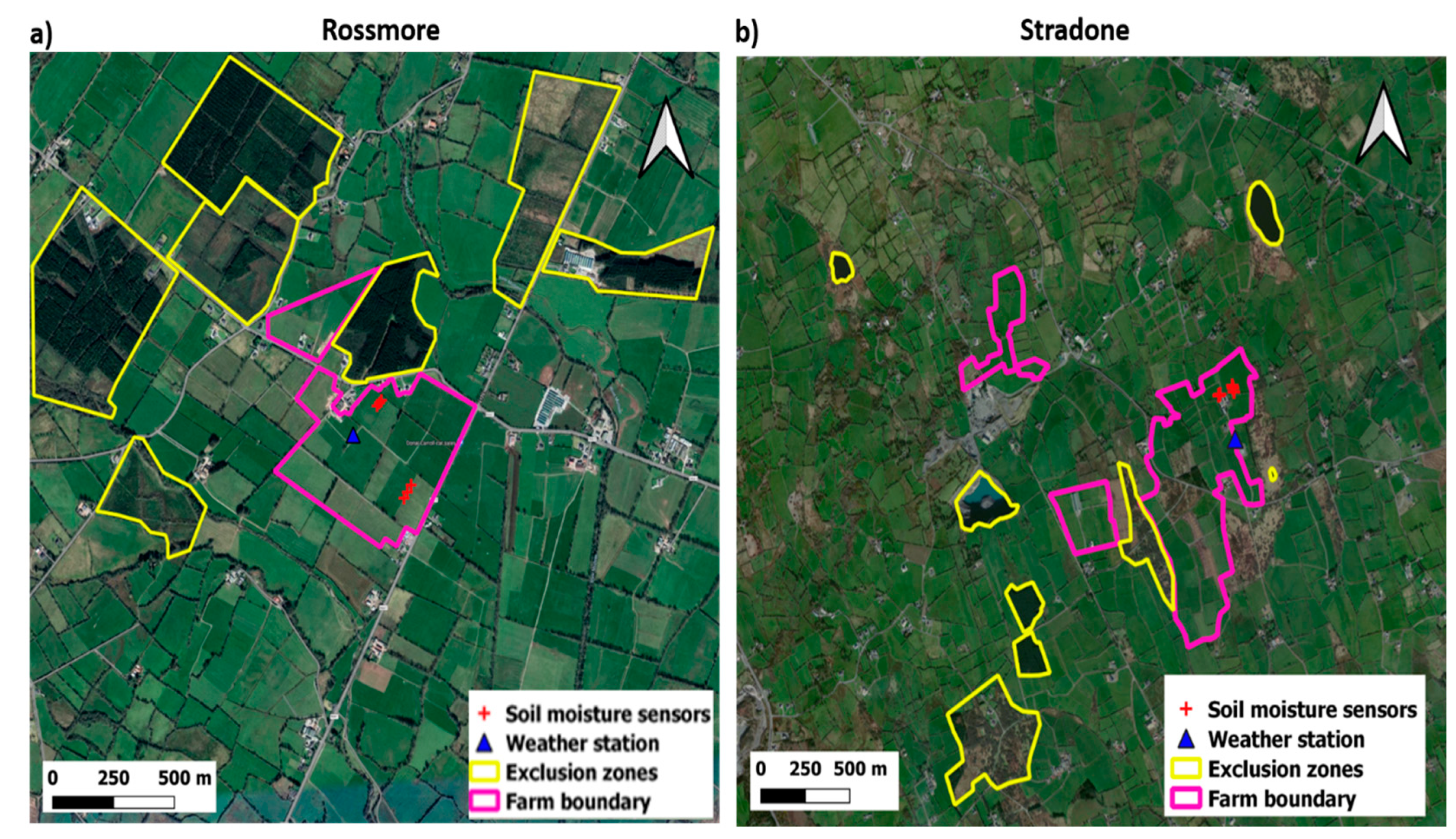
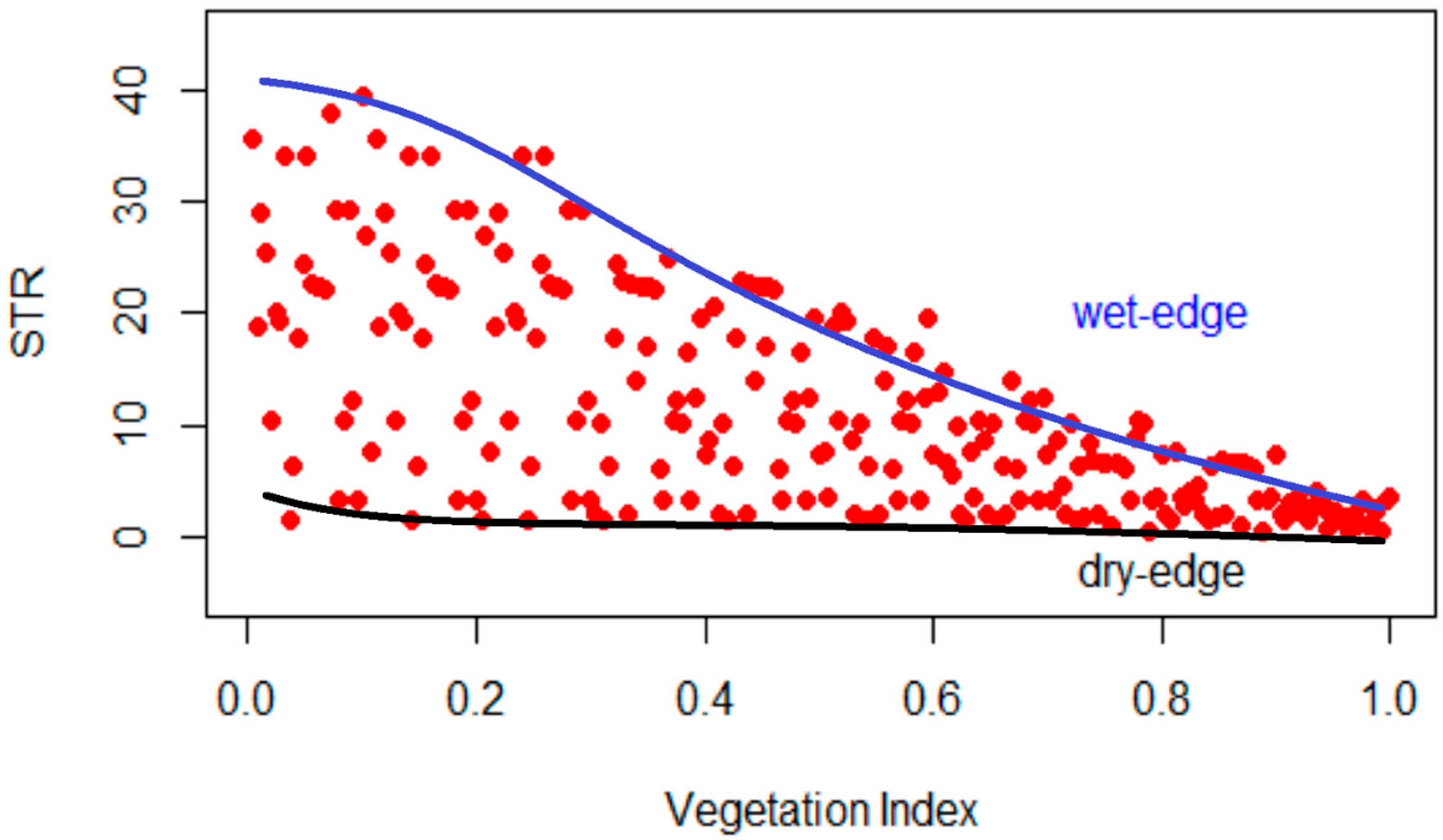
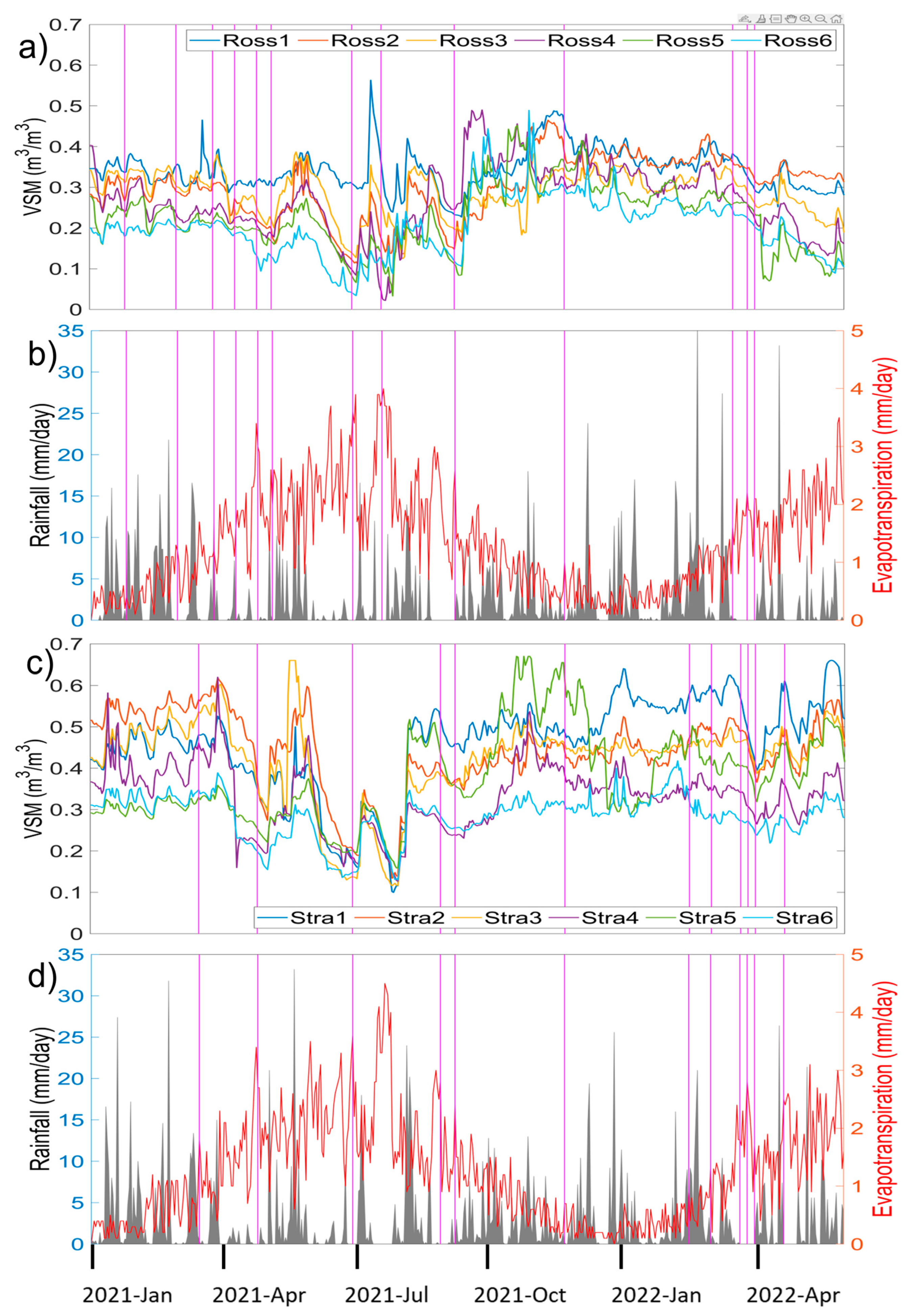
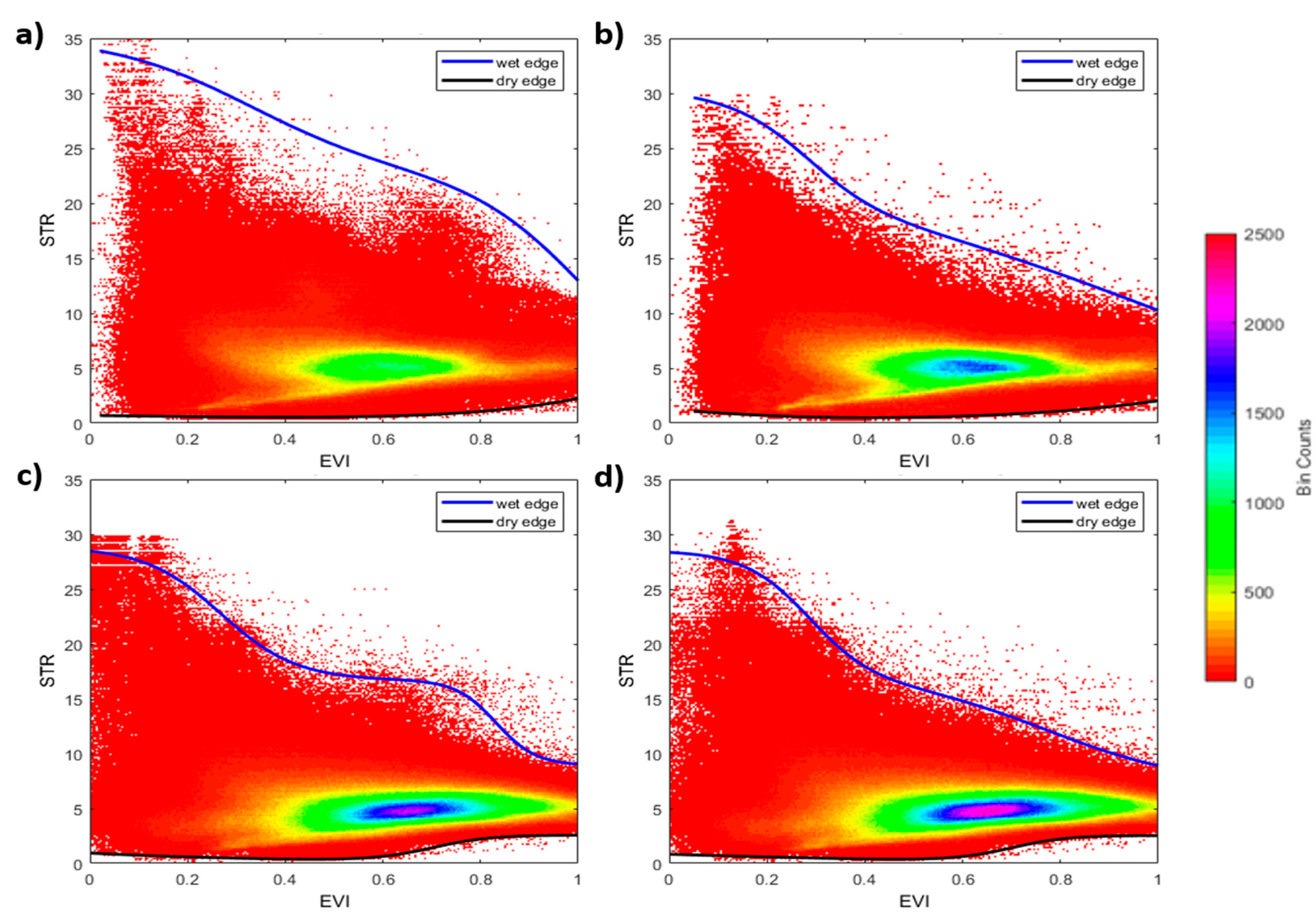
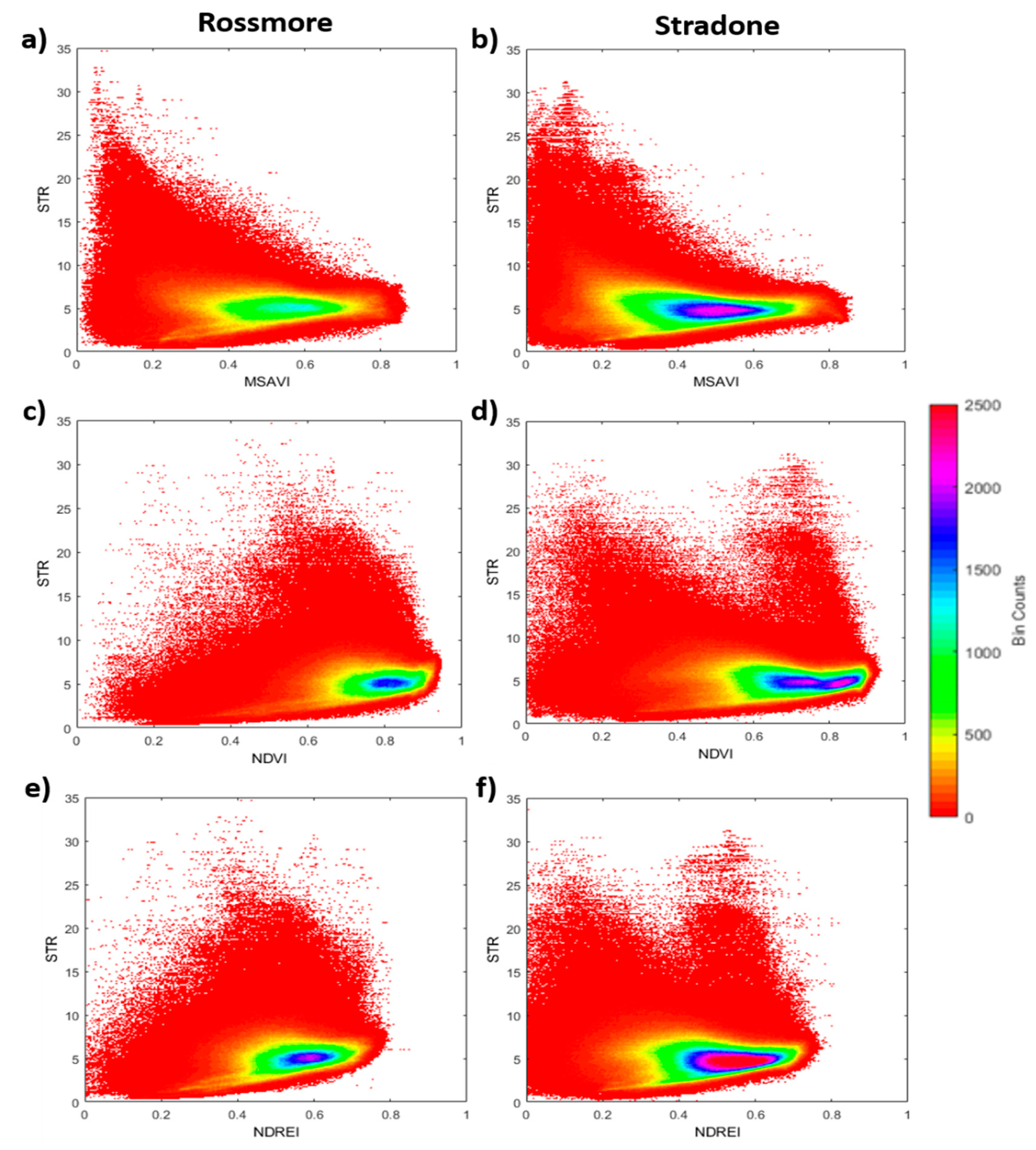
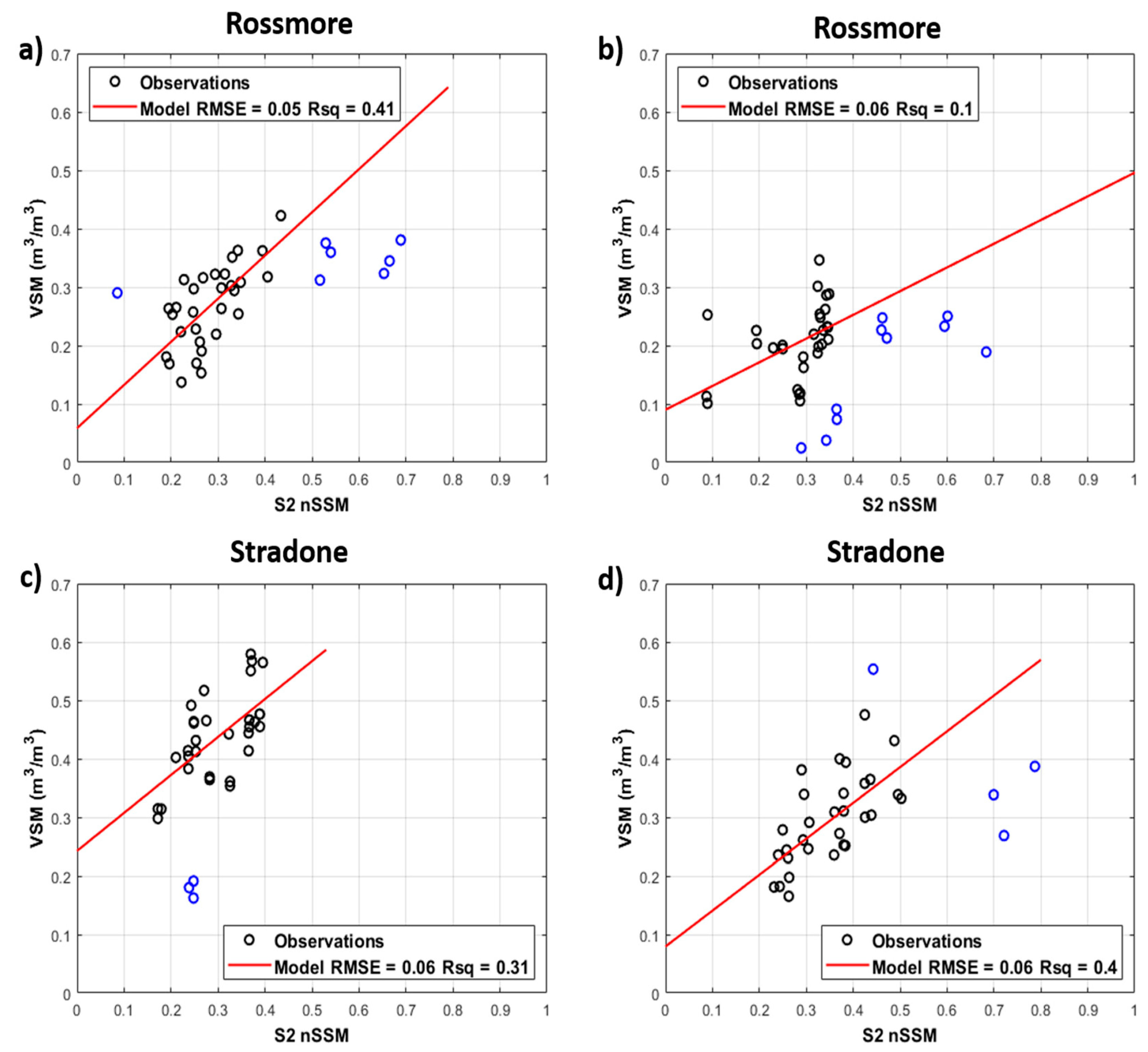
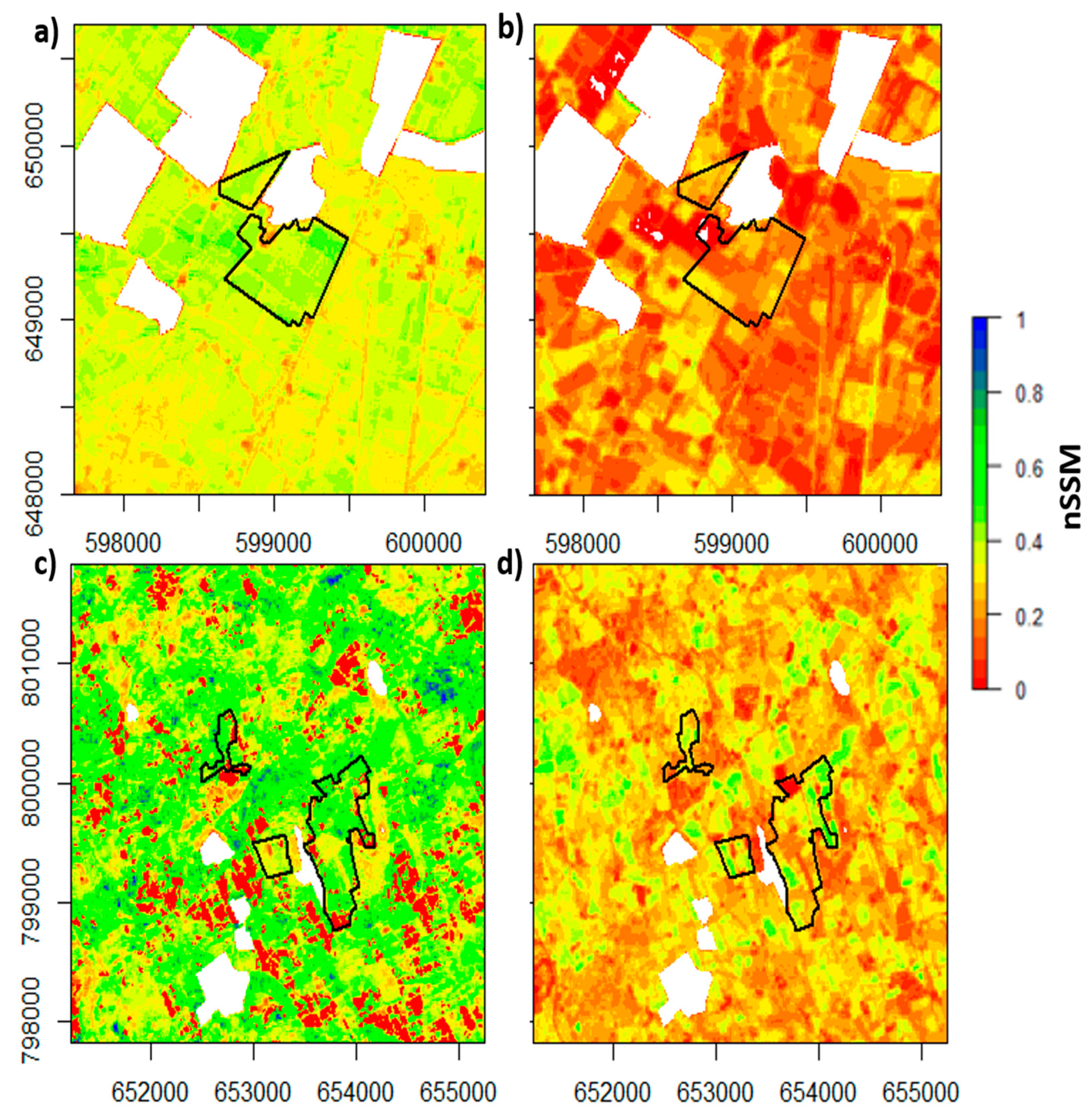
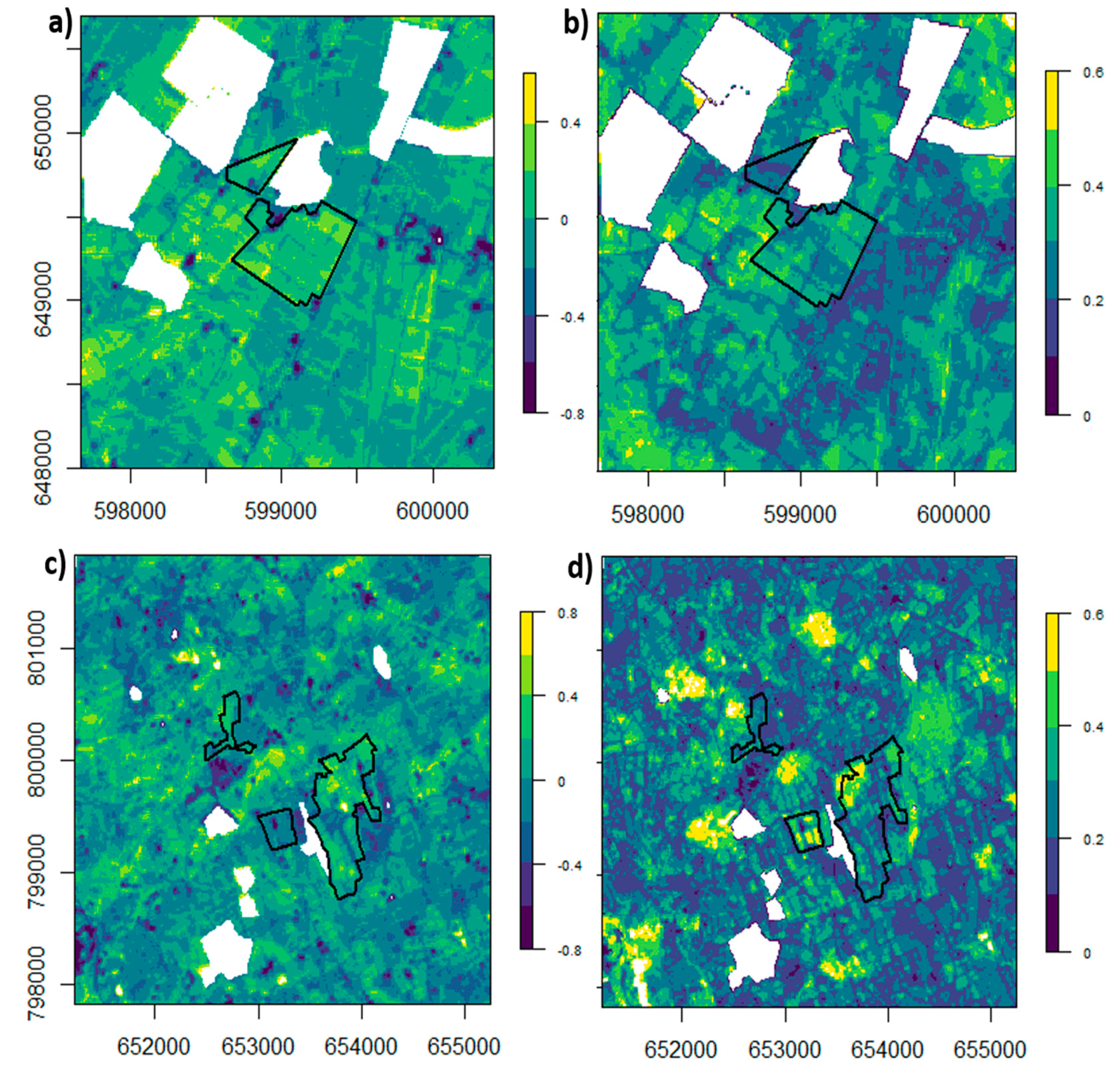
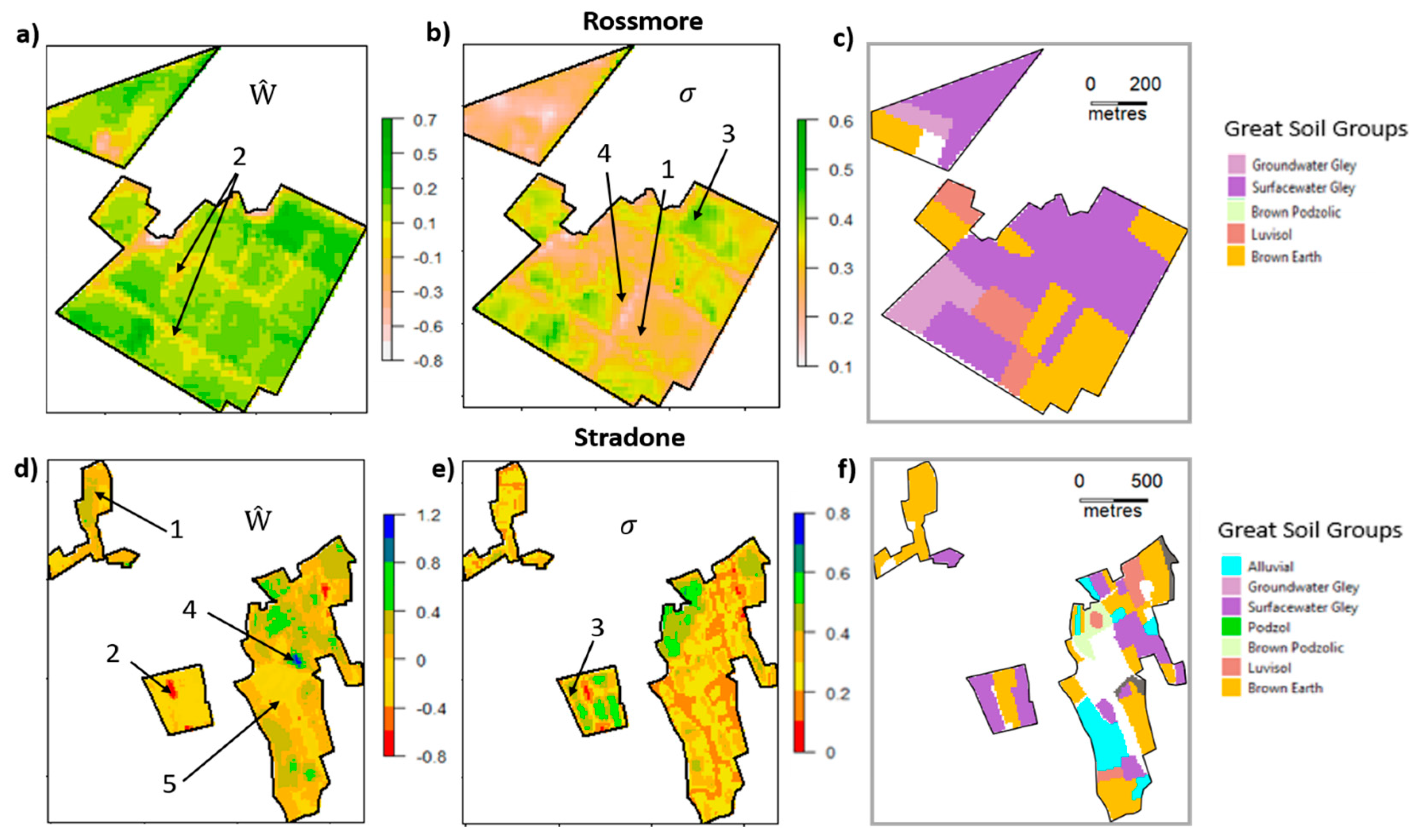
| Sensors | Soil Type | Soil Texture | Saturated VSM (m3/m3) | Residual VSM (m3/m3) |
|---|---|---|---|---|
| Ross 1–3 | Brown Earth | Loam | 0.64 | 0.06 |
| Ross 4–6 | Surface Water Gley | Sandy Loam | 0.50 | 0.04 |
| Stra 1–3 | Luvisol | Loam | 0.59 | 0.09 |
| Stra 4–6 | Stagnic Brown Earth | Clay Loam | 0.57 | 0.08 |
| NDREI | MSAVI | EVI | NDVI | STR | ||
| STR | 1.00 (1.00) | 0.89 (0.92) | 0.58 (0.87) | 0.96 (0.95) | 0.27 (−0.07) | NDREI |
| NDVI | 0.23 (0.17) | 1.00(1.00) | 0.69 (0.93) | 0.90 (0.96) | 0.36 (−0.29) | MSAVI |
| EVI | 0.26 (−0.13) | 0.51 (0.53) | 1.00 (1.00) | 0.57 (0.90) | 0.30 (−0.08) | EVI |
| MSAVI | 0.32 (−0.18) | 0.79 (0.83) | 0.80 (0.83) | 1.00 (1.00) | 0.30 (−0.15) | NDVI |
| NDREI | 0.31 (0.34) | 0.88 (0.89) | 0.51 (0.53) | 0.71 (0.73) | 1.00 (1.00) | STR |
| STR | NDVI | EVI | MSAVI | NDREI |
Disclaimer/Publisher’s Note: The statements, opinions and data contained in all publications are solely those of the individual author(s) and contributor(s) and not of MDPI and/or the editor(s). MDPI and/or the editor(s) disclaim responsibility for any injury to people or property resulting from any ideas, methods, instructions or products referred to in the content. |
© 2024 by the authors. Licensee MDPI, Basel, Switzerland. This article is an open access article distributed under the terms and conditions of the Creative Commons Attribution (CC BY) license (https://creativecommons.org/licenses/by/4.0/).
Share and Cite
Basu, R.; Daly, E.; Brown, C.; Shnel, A.; Tuohy, P. Temporal Stability of Grassland Soil Moisture Utilising Sentinel-2 Satellites and Sparse Ground-Based Sensor Networks. Remote Sens. 2024, 16, 220. https://doi.org/10.3390/rs16020220
Basu R, Daly E, Brown C, Shnel A, Tuohy P. Temporal Stability of Grassland Soil Moisture Utilising Sentinel-2 Satellites and Sparse Ground-Based Sensor Networks. Remote Sensing. 2024; 16(2):220. https://doi.org/10.3390/rs16020220
Chicago/Turabian StyleBasu, Rumia, Eve Daly, Colin Brown, Asaf Shnel, and Patrick Tuohy. 2024. "Temporal Stability of Grassland Soil Moisture Utilising Sentinel-2 Satellites and Sparse Ground-Based Sensor Networks" Remote Sensing 16, no. 2: 220. https://doi.org/10.3390/rs16020220
APA StyleBasu, R., Daly, E., Brown, C., Shnel, A., & Tuohy, P. (2024). Temporal Stability of Grassland Soil Moisture Utilising Sentinel-2 Satellites and Sparse Ground-Based Sensor Networks. Remote Sensing, 16(2), 220. https://doi.org/10.3390/rs16020220






